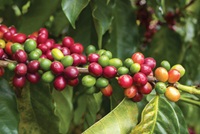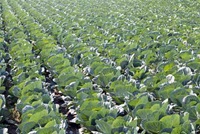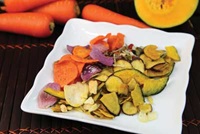
Turning Trash Into Treasure
To solve the problem of food waste, start thinking differently about the challenges it presents.
Article Content
Worldwide, almost a billion people go hungry every day, according to the Food and Agriculture Organization of the United Nations (FAO). Yet, the organization asserts, the underlying problem is not that we don’t produce enough food. It’s that of all the food we do produce, up to one-third is spoiled or discarded before it’s consumed. This represents a tremendous waste of the time, water, energy, and land that went into producing it (FAO 2015a).
The FAO also says that if we could recover even one-third of what is lost or wasted, we could feed those billion people (FAO 2015b). What a worthy challenge! The question now is how best to recover and redistribute this lost or wasted food for human consumption.
What Is Wasted?
According to the FAO, fruits, vegetables, and roots have the highest wastage rates of any food—roughly 45% (FAO 2015b). We are throwing away wilted, blemished, or otherwise imperfect fruits and vegetables as trash. But maybe this “trash” is really “treasure” in disguise, and we are just failing to take advantage of its many possibilities.
I have worked in the food-processing sector for 45 years, advising the U.S. Dept. of Agriculture and private clients on a wide variety of problems. Often we developed solutions or innovations simply by looking at the problem with an open mind.
Maybe to see this “trash” differently, all we need to do is think about it differently. Here are some questions that might open up new ways of thinking about it. Is something missing that could be added? Could the form be changed? Is there a cost-effective, energy-effective way to use it? Can the substance you’re producing be used as a vehicle for another process? Is there a new, different market for what’s being thrown away?
I offer the following examples of problems with food waste, followed by either some possible—or actual—solutions I devised over the years. My purpose is to tickle your imagination and expand your innovative thinking strategies.
 How can we create new products from agricultural and processing culls?
How can we create new products from agricultural and processing culls?
The Challenge: The cherry fruit of the coffee bean is typically wasted. After the coffee bean is squeezed out of the fruit, its skin and pulp are thrown away, winding up as landfill, fertilizer, or hog feed.
The Solution: Using parallel processing, treat the targeted item (the coffee bean) at the same time as its “waste” products. By doing the two processes simultaneously, spoilage can be reduced. For example, after separating the fruit from the bean, the pulp can be placed on an enclosed rack, and then dehydrated over 18–20 hours with warm air blown by a fan powered by solar energy. It could then be made into crackers or chips by admixing with a locally available starch, such as tapioca derived from the cassava root, which grows abundantly in the tropics where the coffee plant thrives. Or the coffee fruit could be made into a jelly or used as a base for food bars flavored with a 2% coffee concentrate mixed with cocoa butter, sugar, and lecithin. That extra “cup of coffee” could be a mocha-flavored bar you carry in your purse or pocket.
The Challenge: Bolthouse and Grimmway, two of the largest carrot producers in the United States, both have enormous amounts of pulp left over after shaving 3- to 4-inch baby carrots out of 20-inch-long oversized carrots, or after making carrot juice.
The Solution: Using parallel processing in the same production line, osmotically infuse a higher concentrated liquid (with the nutrients that were lost in the juicing process) into the pulp residue, and form into Pringle-like chips or carrot fries.
This can be done with any fruit or vegetable. Apple growers making cider also have the problem of leftover pulp, as do potato growers. ConAgra Foods, for example, used sweet potato residue from their french fries to make sweet potato and cranberry energy bars. Celery growers utilize celery stick remainders by using Urschel slicers to thinly slice residue into julienne-cut salad.
What can we do with spilled, wilted, blemished produce?
The Challenge: A major lettuce grower was concerned about throwing away 400,000 pounds of nonstandard lettuce per day. It may have been bruised, damaged, or otherwise not acceptable for retail.
The Solution: During the day, the grower used a vacuum cooler (a 60-foot-long cylinder with trays on racks) to keep the lettuce cool out in the fields. I suggested one solution could be to convert the vacuum cooler into a dehydrator at night. The company could then puree the dehydrated lettuce with vegetables and dressing, compress, and form them into bars to make a value-added new product: a “salad bar.”
The Challenge: Soft and non-acceptable blueberries, rejected by the grower/processor for various reasons (overall appearance or size) were being discarded.
The Solution: Blueberries were immediately frozen, then infused in tanks filled with a high brix solution of monosaccharides (cane or beet sugar) for faster penetration. Bubbling air caused increased movement of the infusion media, bringing new syrup in contact with the blueberry surface. Soaking tanks were lined up with suction lines connected between the bottom of the previous tank to the top of the next, bringing a heavier brix concentrate to each successive tank. When the blueberries reached a level of shelf stability (above 55% sugar), the blueberries were dried.
 How can we address food loss due to poor transportation and storage?
How can we address food loss due to poor transportation and storage?
The Challenge: On a “People-to People” trip to Russia, the director of their largest agricultural cooperative told our small group of invitees that 40% of the cooperative’s cabbage was lost between harvest and consumption due to poor transportation and storage.
The Solution: By bringing the process to the fields using a truck-mounted fluidized bed dryer with a converging set of belts, the cooperative could process the cabbage into paper-thin compressed disks. I had a sample of one of these disks with me to illustrate my point. I demonstrated how cabbage could be rehydrated, using hot tea water to rehydrate a hockey-puck-sized disk of freeze-dried, reversibly compressed green beans. I suggested this could be done on the cabbage right there in the fields, bringing the process to the produce. Their customers could make their daily cabbage soup out of the 40% the farmers were throwing away.
The Challenge: In another example of waste due to limited transportation, mangoes in Gambia, Africa, were being lost to spoilage, becoming overripe while waiting for ships to arrive.
The Solution: Mangoes were able to be stored until transport was available at a later time by osmotically infusing them in drums with a cane sugar stabilizer, beginning with a brix of 30% cane sugar and increasing the solution daily by 5% until the brix concentration reached 55% sugar.
What can we do if storage space is at a premium?
The Challenge: Feeding 50 servicemen regularly in a submarine with limited storage space.
The Solution: From 1970 until the early 1990s, I contracted with the U.S. government to address this challenge. Green beans, peas, carrots, onion, corn, spinach, mixed vegetables, apples, and cherries were freeze-dried and then subjected to 1,000–2,500 pounds pressure per square inch. Then they were formed into disks and vacuum canned, back-flushed with nitrogen. The use of compression technology reduced the product volume down to as little as one-sixteenth of its original volume. One can of six disks fed 50 sailors. When rehydrated, the vegetables and fruits returned to their original size, shape, and texture.
How can we improve processing efficiency?
The Challenge: Food producers traditionally use steam or water to blanch potatoes when making french fries.
The Solution: The infrared dry blanching process, invented by Zhongli Pan of the University of California, Davis, achieves a 40% energy reduction by using infrared radiation to heat up, blanch, and dehydrate food in a single step. The process also reduces water usage, lessens contamination, and simplifies cleanup. By retaining more potato starch, there is more volume produced. The french fries have better color, aroma, and taste, and use less oil. The equipment is also portable, since equipment can be built on wheels. There are no harmful effects to humans or the environment, and the product retains more nutrients, phytochemicals, and flavors compared with those produced by conventional methods of blanching.
Can packaging design improvements save processing time?
The Challenge: A major manufacturer asked how to save energy by speeding up reheating its frozen pizza from 18 minutes to 9 minutes in a conventional oven.
The Solution: We used black aluminum-coated packaging to increase the heat transfer. I also recommended using ingredients high in fat (cheese, sausage, and olives) to expedite the process.
Can we prolong the storage life of food?
The Challenge: The U.S. military’s Meals, Ready-to Eat (MRE) program requires appetizing food that can be shipped easily and has high nutritional value and a long shelf life.
The Solution: Dehydration methods like freeze-drying, air drying, and vacuum drying help to ensure excellent shelf stability and quality retention. Fresh fruit is sliced and poured into a vertical form to make a block 18 inches by 20 inches by 3-1/2 inches with a 29-degree Brix sugar solution and then frozen, sliced, and freeze-dried. Using a process of freeze-drying and vacuum sealing back flushed with nitrogen in a laminate of polyethylene, aluminum, and polyester packaging, the shelf life for these fruit desserts (peaches, strawberries, and mixed fruit) is three years. The freeze-dried, compressed vegetables for use on submarines for the military had an even longer shelf life. I once demonstrated reconstituting a disk of green beans preserved by this method for some school children. As I ate them, they asked me how old the beans were; “25 years old” was my reply.
 What new markets are there for products made from “recovered” food?
What new markets are there for products made from “recovered” food?
The potential for these products is limitless. Health-conscious consumers are demonstrating they will buy more healthful snacks. A variety of alternatives to candies and cookies can be made using a combination of dehydration and formed food technology. These processes require low amounts—or even no amounts—of sugar for preservation; target audiences might include dieters, cancer survivors, and the elderly. Their light weight would appeal to backpackers and hikers.
The food combinations and mixtures for new products are also unlimited. We have only scratched the surface of possibilities. Here are a few examples of products I have developed over the years. Freeze-dried cinnamon applesauce rings can be made from applesauce combined with 10% cracker crumbs and run through a piston-like cookie press, formed into slices, freeze-dried, and then eaten like a cookie. Not just health food stores are selling dried vegetables extruded into french fry shapes; now mainstream supermarkets and superstores like Costco sell them. These include dried carrots, beets, and celery. Green bean brittle was one of my personal favorites; healthier than peanut brittle, it is made with french cut green beans, almond slivers, and maltodextrose, which functions as a binding agent.
Dried vegetable chips with dip are a great substitute for salted snack chips. Parents might even notice their children consuming more vegetables in this different format. As a substitute for blueberries, raisins can be infused with more than 40 flavors—from sour cherry to jalapeno and salty to sweet to savory. And beans can be infused with a variety of flavors and then dried like corn nuts.
How can we help feed the hungry in our own country and worldwide?
In Lubbock, Texas, a national food bank called Second Harvest Heartland took farmers’ and producers’ surplus donations. Frito-Lay donated potatoes, while local farmers contributed oversized carrots and onions. These vegetables were dehydrated and blended into soup mixes and then distributed through food banks nationally and worldwide.
On a personal basis, everyone can get involved. There are now many groups who glean, harvest, collect, rescue, or recover fruit or produce for charitable purposes. For example, Senior Gleaners of San Diego County are volunteers 55 years of age and over who glean surplus food from fields, groves, backyards, stores, and restaurants to distribute to nonprofit agencies that feed the hungry throughout San Diego County. To find a group in your area, check the national gleaning/harvesting directory at villageharvest.org/harvesting directory.
These examples are just some of the ways we can reduce food waste. The possibilities are endless, and the future is bright. This past June, three international summits discussed how to reduce food loss and waste. In addition, the FAO and Messe Düsseldorf, a trade fair organizer, are collaborating with donors, agencies, and financial institutions, as well as private sector partners (the food packaging industry and others) to develop and implement a worldwide program on food loss and waste reduction (FAO 2015b).
Open your mind and imagination to see what treasures nature provides for us in all parts of our food. We can save energy, water, money, time, and maybe even the lives of the billion people in the world who go to bed hungry every night.
Latest News

How to Achieve EPR-Forward Packaging
In this two-part series, the author explores the history of Extended Producer Responsibility (EPR), what is needed to help EPR succeed, and how brands can best prepare for EPR.

Keeping the ESG Promise
An infographic describing food and beverage companies’ outlooks regarding ESG initiatives.

Ag-Tech’s Passionate Pragmatist
Agrologist and agricultural futurist Robert Saik wants to feed the world better and more sustainably. To make that happen, leveraging science and technology will be critical.

The State of Sensory Science
Three seasoned sensory scientists share their thoughts on the complexity of measuring consumer perceptions, the value of academic/industry collaboration, the evolution of the discipline, and why they love what they do.

Packaging for Better Food Security
In this article, readers will find an update on the role of packaging in enabling a more food-secure population.
